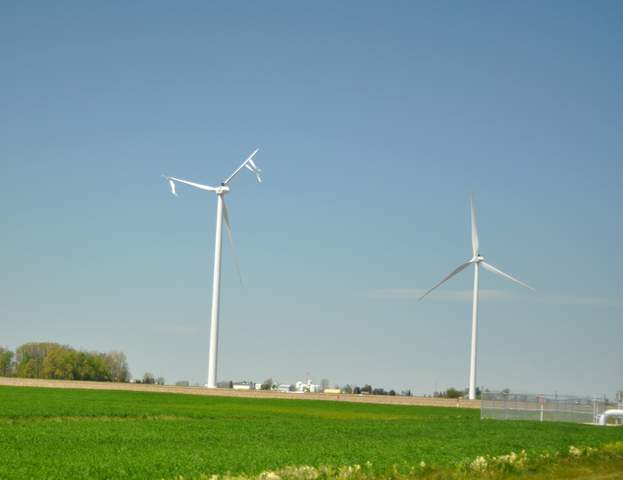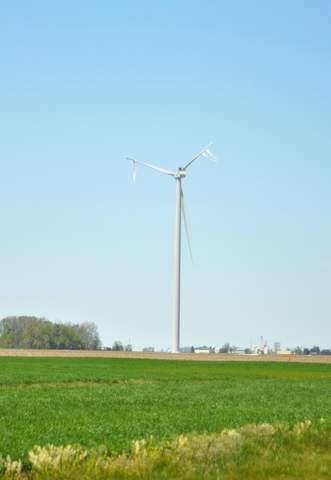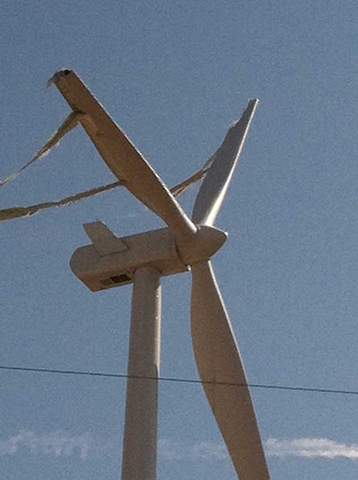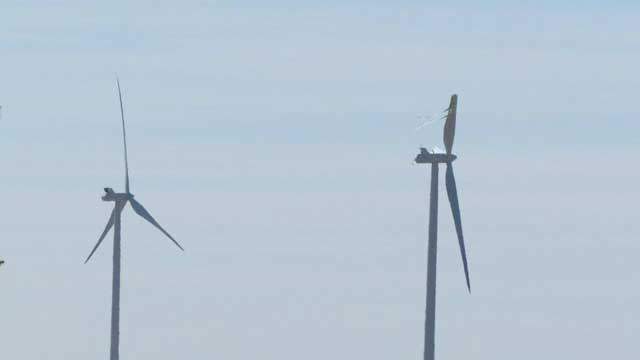Entries in wind energy (195)
1/19/2012 Wind Turbine Noise: The Sound of Trouble
From Nova Scotia
INCREASING TURBINE NUMBERS COULD MEAN LARGER SETBACKS
By Cheryl LaRocque
Source: Amherst Daily News
July 19, 2012
AMHERST – For industrial wind turbines, low frequency sound emissions range: one person may not hear a noise a second person hears clearly, while a third person finds the noise loud and uncomfortable.
To date, some residents of Amherst and out of town visitors said: “I don’t hear them; the turbines don’t bother me; the turbines hum and/or drone and keep me awake at night; they gave me an ongoing migraine; they give me daily headaches; the turbines are noisy and I/we can’t sleep at night.”
Researchers explain individual hearing sensitivity varies greatly. If you are wondering why, the explanation may be tucked in the inner ear in a cluster of tiny, interconnected organs.
In an article published in the Bulletin of Science Technology & Society, 2011, Wind Turbines could Affect Humans, by Alec Salt and James A. Kaltenbach explained, wind turbines generate low-frequency sounds that affect the ear.
“The ear is superficially similar to a microphone, converting mechanical sound waves into electrical signals, but does this by complex physiologic processes.”
Serious misconceptions about low-frequency sound and the ear have resulted in a failure to consider how the ear works.
“Although the cells that provide hearing are insensitive to infrasound, other sensory cells in the ear are much more sensitive, which can be demonstrated by electrical recordings,” wrote Salt and Kaltenbach. “Responses to infrasound reach the brain through pathways that do not involve conscious hearing but instead may produce sensations of fullness, pressure or tinnitus, or have no sensation.”
There is overwhelming evidence large electricity-generating turbines cause serious health problems in a nontrivial fraction of residents living near them, explained Carl V. Phillips, MPP, PhD in his article Properly Interpreting the Epidemiologic Evidence About the Health Effects of Industrial Wind Turbines on Nearby Residents. The article was published in the Bulletin of Science Technology & Society (2011).
“These turbines produce noise in the audible and non-audible ranges, as well as optical flickering, and many people living near them have reported a collection of health effects that appear to be manifestations of a chronic stress reaction or something similar,” explained Phillips, a consultant and author specializing in epidemiology, science-based policy making and communicating scientific concepts to the public.
Dr. Robert McMurtry, former dean of medicine at the University of Western in London, Ont., published a case definition to facilitate a clinical diagnosis regarding adverse health effects and industrial wind turbines.
There is a move toward a safe setback of turbines of two kilometres from homes, explained Dr. John Harrison, physicist from Queen’s University in Kingston, Ont., in an email interview.
“In the absence of any independent studies of adverse health effects, a precautionary principle suggests all provinces and territories in Canada should adopt a two-km setback.”
Harrison’s expertise is in the properties of matter at low temperatures with emphasis on high frequency sound waves. For the past five years he has studied wind turbine noise and its regulation.
As the province of Nova Scotia continues to pursue and approve wind energy developments, it is important it take into account the larger the turbine and the increase in numbers of turbines would also mean an increase in setback distance, explained Richard R. James in a phone interview from his office in Okemos, Mich.
James is adjunct professor at Michigan State University and Central Michigan University with the department of communication disorders.
Richard R. James, INCE (Institute of Noise Control Engineering) is a certified noise control engineer and has been actively involved in the field of noise control since 1969, participating in and supervising research and engineering projects related to measurement and control of occupational and community noise for major US and Canadian Manufacturers. Since 2006, he has been involved with noise and health issues related to industrial wind turbines.
Other countries including Australia, Denmark, France, New Zealand and Germany have instituted strict regulatory requirements regarding industrial wind turbine setback or are in the process of tightening criteria that experience has shown are not protective. The Danish EPA (their regulatory body) recently instituted stricter regulations that require the turbine’s emission of low frequency sound be addressed.
7/17/2012 Taking it to the streets: protestors block truck carrying wind turbine parts
WCAX.COM Local Vermont News, Weather and Sports-
From Vermont
PROTESTERS BLOCK ROUTE 100 IN OPPOSITION TO LOWELL WIND PROJECT
Jennifer Hersey Cleveland, Staff Writer
SOURCE Caledonian Record via Mountain Talk
July 17, 2012
LOWELL — A stand-off between police from seven law enforcement agencies and more than 100 industrial wind protesters ended peaceably when police and organizers came to a compromise Monday afternoon.
The protesters, including members of the Mountain Occupiers and Newark Neighbors United, blocked both lanes of Route 100 for about two hours, preventing a truck hauling a wind tower section from entering the staging site.
They chanted “When our mountains are under attack, what do we do? Stand up, fight back!” in their opposition to the 21-turbine project being constructed on the Lowell Mountain range by Green Mountain Power.
The protesters stayed on the far side of the road for much of the morning, singing in solidarity and holding placards with messages like “Greed Isn’t Green” and “Big $-wind-le” written on them. Skeletal figures with extended arms turned like wind turbine blades, and organizer Ira Powsner led the chants of “Mountains — yes! Profits — no!” to the beat of Bread and Puppet drummers.
Their message came through organizer Steve Wright of Craftsbury. The project, which is being sold as “green” energy, does nothing to alleviate dependence on foreign oil, he said. “It is the blackest of black energy.”
It will devastate wildlife habitat, and it is not a stable source of power, Wright said.
As the truck hauling a piece of a wind tower approached, protesters started moving into the roadway, blocking the truck’s path.
Before the bulk of the group could get to the front of the truck, Lamoille County Sheriff’s deputy Claude Marcoux had already arrested and handcuffed Ira Powsner and his brother Jacob Powsner of Ira for disorderly conduct by obstruction.

At that point protesters, who formerly had been willing to stand on the sidelines, moved into the roadway – blocking both lanes.
The movement intensified, with people yelling, “Shame on you!” and “Turn it back!” to the pounding of drums.
Essex County Sheriff Trevor Colby arrived and parted the wave of people with his cruiser, but the crowd swallowed up his car just as quickly as he passed by.
Corporal Dan Kerin of the Williston barracks was next on the scene, and quickly began moving the protesters to the sidelines.
Kerin yelled and pushed some people backward, which at first was effective and then elicited stronger opposition, with people moving back into the spaces Kerin had cleared, dancing and waving flags depicting scenes of destruction.
About 40 law enforcement officers from five state police barracks, three sheriff departments, U.S. Border Patrol, Fish and Wildlife, and the Department of Motor Vehicles arrived in the moments soon afterward, largely staying on the sidelines until a plan was formulated.
Lieutenant Kirk Cooper, commander of the Derby barracks, quickly entered the crowd of protesters upon his arrival, quelling the shouting and asking people to consider their options.
Cooper told the protesters that he understood why they were there and said they have every right to stand up for what they believe in, but not the right to block traffic.
“I’m not going to fill you full of crap,” Cooper said. He said the protesters had two options: stand on the side of the road or be removed from the road.
“We’re going to be forced to have to remove you. I honestly don’t want to do that,” Cooper said.
One of the protesters said she thought the group would be fine with allowing all other traffic to pass — except that one truck.
The situation had come to an impasse, and worried looks started sprouting on people’s faces.
Officers, including one holding the leash of a large German shepherd, were all in possession of plastic hand restraints and appeared prepared to quell the uprising.
That’s when Don Nelson’s voice hushed all other sound. “We’ve made our point,” Nelson, who is in a civil court dispute with GMP over land rights in the project, said.
Some protesters were nodding in agreement, while others were shaking their heads and saying things that indicated they were not willing to back down.
Lamoille County Sheriff Roger Marcoux and Cooper spoke with Nelson and organizers Pat O’Neill of Westfield and Wright, in a tight-knit huddle.
Nelson, Wright and O’Neill asked the officers to give them a chance to convince the crowd to move to the side, but only if the Powsner brothers were released.
The trio spoke with Will Young, who turned and commended the protesters for making their point.
“We have done our job here!” Young said. “We have shown that this is a corrupt, evil system that destroys our ridgelines.”
The industrial wind opposition has to use its resources wisely, Young said, and putting fine money in the hands of the state is not putting money to good use, he said.
O’Neill said the Powsner brothers would still be cited for disorderly conduct but would not be taken into custody after Sheriff Marcoux said he had no authority to un-arrest people and that the state’s attorney’s office would decide whether or not charges would be brought in court.
With the protesters largely in agreement, and slowly moving back from the truck, O’Neill shouted, “But this truck doesn’t move until Ira joins us!”
Wright held the fort in front of the truck, waving a large Vermont flag, until police released the Powsner brothers.
Shouting, “Governor Shumlin, do you hear us now?” the crowd slowly moved aside and allowed the truck to move into the driveway of the wind project.
GMP spokesperson Dorothy Schnure said, after all was calm, “It’s unfortunate that the people who oppose the project blocked traffic… It’s unfortunate for locals to be held up for two hours.”
But she said despite the delay Monday, construction was still on target for completion by the end of the year.
Schnure said that 75 percent of Lowell voters approve of the project that she says will provide power to 24,000 homes and that the Public Service Board found to be good.
The protesters regrouped and Wright delivered closing comments.
“We’re on a track now to stop that kind of crap,” he said. The next step is creating a statewide organization to address industrial wind.
He reminded the crowd that the Public Service Board will hold a public meeting Tuesday at 7 p.m. at the Newark Street School regarding the proposed 30-turbine project there.
“We all have an interest in this,” Wright said. “This was a big win.”
7/13/12 Big Wind VS The Little Guy: Will the Saint Croix HHS Step In?
WIND FARM OPPONENTS SEEK COUNTY SUPPORT
Jeff Holmquist
SOURCE: Pierce County Herald www.piercecountyherald.com
July 12, 2012
The St. Croix Health and Human Services Board will look into health concerns raised by residents of the Town of Forest related to a proposed wind farm in that community.
For the second time in several months, a group of Forest Township residents filled the board room at the Health and Human Services building in New Richmond, Wis. to ask for help.
The HHS Board had previously agreed to send a letter to the Wisconsin Department of Health Services asking for additional study of the possible health impacts of wind energy projects.
Opponents of the Highland Wind Farm project in Forest Township, proposed by Emerging Energies of Wisconsin LLC, say that people living near existing wind farms have suffered varying health impacts ranging from headaches, sleep deprivation and hearing loss.
In a response from Wisconsin Department of Health Services Deputy Secretary Kitty Rhoades, the state is relying on three previous studies on wind farms. All of those studies indicate that the impact on a person’s health is non-existent if proper setbacks are followed, Rhoades wrote.
Wendy Kramer, public health officer for St. Croix County, admitted there is a great deal of controversy related to the health impact of wind turbines near homes.
Forest resident Brenda Salseg said state rules require a minimum 1,250-foot setback from existing homes. At least one industry recommendation calls for a minimum of a 1,640-foot setback from homes, she reported.
If the 41 Forest turbines are allowed to be constructed, Salseg said, it’s likely that some residents will have turbines too close to their home and their family’s health will be in jeopardy.
“This is serious stuff,” she said. “This could become a health emergency in St. Croix County.”
Salseg said she also expects more wind farm proposals in the future, which will have an impact on other parts of the county.
HHS Board Chairman Fred Horne said he will distribute the information that Forest residents are circulating concerning possible health effects and the board will discuss any future action at its meeting in August.
If the group chooses, Horne said, county officials could present testimony about health concerns as part of the upcoming Public Utilities Commission hearings in October.
The Wisconsin PUC will make the final determination about whether the Highland Wind farm will move forward. The Forest project is greater than 100 kilowatts in size, making the state agency the one with final say in the matter.
The Highland project was smaller than 100 kilowatts when it was first proposed, but local opponents worked hard to recall Forest Town Board members who were supportive of the project. The new town board eventually rescinded the required approvals, but then developers increased the size of the project to bypass the local approval process.
7/10/12 If she was your daughter, what would you do? If it was your home, what would you do?
WBAY-TV Green Bay-Fox Cities-Northeast Wisconsin News
WIND TURBINE OPPOSITION MOUNTS; BROWN COUNTY FAMILY TELLS OF DAUGHTER'S HEATH PROBLEMS
Written by Hannah O’Brien
Source: Gannett Wisconsin Media www.postcrescent.com
July 8, 2012
The Ashleys say their daughter Alyssa’s health problems are related to the Shirley Wind Project wind turbines that were built near their home in late 2010, and the only way to stop the headaches, ear pain and sleep deprivation was to move away from turbines.
MORRISON — Sue and Darryl Ashley moved their family out of their Glenmore home last summer and are now working to pay mortgages on two houses so their 16-year-old daughter can find relief from constant headaches, ear pain and sleep deprivation.
The Ashleys say their daughter Alyssa’s health problems are related to the Shirley Wind Project wind turbines that were built near their home in late 2010, and the only way to stop the headaches, ear pain and sleep deprivation was to move away from turbines.
“After staying away from my home for a week and a half, my symptoms started to subside,” Alyssa said, adding that the health problems caused her to struggle with school work. “I could sleep again and my headaches were lessening. The longer I was away, the better I felt.”
Because of health problems experienced by families like the Ashleys, state Sen. Frank Lasee, R-Ledgeview, is pressuring the Public Service Commission to change its rules for the construction of wind turbines.
“This really is about our government not protecting our citizens,” Lasee said Sunday during a news conference at Way-Morr County Park in Morrison, about five miles from wind turbines in Glenmore.
Lasee on Wednesday will present multiple published reports that cite the dangers of wind turbines to each of the members of the Public Service Commission, which is responsible for regulating the rates and safety of electric, natural gas and water utilities. He hopes the commission will suspend the current rules for wind turbines, and that a new commission will be created to write new rules.
The Public Service Commission could not be reached Sunday for comment.
The commission’s Wind Siting Council in 2010 released rules for wind turbines and said there was insufficient proof of negative health effects from wind turbines to support stricter rules.
“The council has concluded that the scientific evidence does not support a conclusion that wind turbines cause adverse health outcomes,” according to the council’s final recommendations to the Public Service Commission, which were released in August 2010.
Dr. Herb Coussons, who also spoke during Sunday’s news conference, said health effects of the audible noise from wind turbines can include sleep deprivation, elevated blood pressure, diabetes, weight gain and an increased risk of heart disease. Wind turbines also can be responsible for stray voltage and groundwater contamination, he said.
“The wind mill is on and off, on and off, on and off and unrelenting,” he said. “The solution though is very, very simple. Puth them where there aren’t people.”
Lasee hopes new rules will be implemented to prevent wind turbines from being built within a mile of residents’ homes, and that property owners’ consent must be given before turbines can be built nearby. The current rules state wind turbines must be 850 feet away from homes, Lasee said.
“I think they’re too close to people’s homes,” Lasee said, adding that Brown County is too densely populated for wind turbines.
“The Ashleys are not the only family who moved out of their homes,” he said.
The Ashleys last year bought a second home, but still have to pay a mortgage on their Glenmore home, “a house that we can’t live in,” Alyssa said.
While the Ashley’s’ new home helps keep Alyssa’s symptoms at bay, moving away has not cured her health problems, she said.
“Last week, when I traveled to Tennessee for a youth rally, the bus drove through large wind farms and I immediately experienced ear pressure and eventually pain, even though I hadn’t been exposed to turbines in months,” she said, adding that she wondered “if this damage and sensitivity would ever leave.”
SECOND FEATURE:
BROWN COUNTY WIND TURBINE BATTLE
By Deandra Corinthios
Source: WGBA-TV /NBC26 / www.nbc26.com
July 8 2012
GLENMORE, WI –A battle over the effects of wind energy are blowing into Brown County again. Several families who live near the turbines believe it is causing them health problems.
State Senator Fank lasee says he’s taking their concerns to the capitol. Senator Lasee wants the rules for wind turbine placement changed, he wants the turbines farther away from people’s homes.
Several families in the Glenmore-Shirley area say they have been forced to abandon their homes to keep their families safe.
Darrel Cappelle uprooted his wife and two young children from their home a year and a half ago after he says wind turbines made them sick.
“We’re about 7 miles way from the turbines now and within a week sleep patterns returned, my wife is feeling much better my son seems to be doing better,” said Cappelle.
Cappelle says the humming and flicker shadow of the turbines kept them up at night, gave his wife anxiety attacks and their kids suffered from ear infections.
“With the refrigerator running or washing machine going you could just hear this constant buzzing,” said Sarah Cappelle.
Senator Frank Lasee will present a stack of reports on the negative impacts of wind turbines to the agency that oversees wind energy in Wisconsin, the Public Service Commission.
Governor Scott Walker proposed a 1,850 foot set-back but Senator Lasee says that’s not enough. He wants the turbines at least a mile away from homes.
“It is my hope the PSC will look favorably upon my request to suspend the current rules, so that the projects being proposed will not move forward, and reconvene a new wind siting council that will give us better setback rules,” said Lasee.
The issue was brought to a vote back in May but the senator was one vote short of getting the rules changed. He hopes this time will be different for the sake of families like the Cappelles.
“Our hope is that eventually we can move back home,” said Darrel Cappelle.
NBC26 tried calling Duke Energy, the company that owns the Shirley windpower project about Senator Lasee’s plans but they haven’t returned our calls yet. The Senator will be making his case to the PSC on Wednesday.
4/25/12 Another one bites the dust AND Different state, same nightmare: wind developers pushing for 1000 foot setbacks from 500 foot turbines
MASSIVE WIND DAMAGE CAUSED BY WINDY CONDITIONS
Source WANE, www.wane.com
April 24 2012
A wind turbine in Paulding County, Ohio has been badly damaged.
According to a spokesman with EDP Renewables, the turbine, which is located near Payne, had two of its blades sheared early Tuesday afternoon.
Representatives from EDP Renewables have closed the site, which is known as Timber Road II and said no one was injured by the falling debris.
That particular turbine was completed in 2010 and is still under warranty by its manufacturer Vestas which is conducting their own investigation.
EDP is monitoring other turbines in the area for any signs of fatigue or damage.
NewsChannel 15 received several pictures a damaged turbine in Paulding County. We’ve added them to this story.
New York State
PUBLIC HEARING DRAWS FULL HOUSE
By Chris Hoffman,
Source: Madison County Courier, www.madisoncountycourier.com
April 25, 2012
The crowd at the Public Hearing before the Town of Madison Planning Board nearly filled the 350-seat auditorium at Madison Central School on April 18. The hearing opened at 7 p.m. and more than 40 local residents read comments until almost 10:30 p.m.
Comments were overwhelmingly opposed to the project, with only 7 in favor, most of whom were members of the Stone Family who live near the existing windmills on Stone Road and who stated they have experienced no adverse affects. Several speakers subsequently pointed out, however, that comparing the two projects is meaningless because of the difference in size, scope, and siting.
The proposed wind farm would site 36 turbines within and around a residential area that contains over 150 homes, with each turbine nearly 500 feet tall and within setbacks of 1,000 feet from existing homes. Additionally, the proposed turbines are a new model with no track record, as they have never been used anywhere in the country.
Speakers represented a broad demographic spectrum – people who have lived here since they were young children; people who relocated here to get away from industrialization and overcrowding; fourth generation farmers and new farmers; business owners with past experience in the energy and construction industries; homeowners who have lived here for decades and built or bought their homes because of the proximity to a serene natural environment.
Many speakers addressed specific sections of the draft Generic Environmental Statement (dGEIS) submitted to the Planning Board for review, pointing out numerous flaws and inadequacies. Jane Welsh stated that the Planning Board should never have accepted the dGEIS for review because it is incomplete as it stands, and should have been returned to the developer for corrections.
Laura Wilson of Hamilton Village Real Estate and Sue Martin of Martin Realty both spoke to the “blatant inadequacy” of the section in the dGEIS concerning real property values, which sites a 2009 report that states, “neither the view of the wind facilities nor the distance of the home to those facilities is found to have any consistent, measurable, and statistically significant effect on home sales prices.” Both Wilson and Martin, who have more than 50 years of combined experience in the local real estate market, cited studies and data that refuted this conclusion, and termed the report relied on by the dGEIS as fatally flawed and outdated.
Bob Albrecht spoke of childhood memories of growing up on Thayer Road, where he and his brother Carl used to play in the woods among the trees, trees that he has always referred to as the “Witness Trees,” because they have been there so long that they bear witness to the generations of families who live in this area, noting that “individuals have a reasonable expectation to the quiet enjoyment of their homes.”
Eve Ann Shwartz spoke on behalf of the Hamilton Town Council.
“The Hamilton Town Council believes that the proposed project would violate Town of Hamilton laws adopted to protect our citizens from the negative impact of improperly planned windpower projects,” Shwartz said. “With the currently proposed siting, Hamilton properties bordering on the Madison town line may be subject to quality of life impingements and health concerns such as flicker effect and noise pollution. The Town of Madison’s current regulations and buffers are not as protective as those provided under the Town of Hamilton’s zoning.”
“While we understand that the Town of Madison’s laws control the development of land in Madison, we believe that the siting of wind farms is a unique type of land use,” she added. “Because wind turbines can be seen for many miles and the noise they generate and the shadows they create can extend for thousands of feet, their impacts can extend beyond town boundaries. We respectfully request that you honor the intent of our laws and modify the siting of the proposed project.”
Shwartz also addressed the potential impact on property values.
“The proposed project is sited within one mile of 92 properties in the Town of Hamilton, covering 1,807 acres with an assessed value of $8,716,400,” Shwartz said. “According to numerous studies, wind turbine projects have a negative impact on nearby property values. A recent study of more than 11,000 property transactions in Franklin, Clinton, and Lewis Counties found an average reduction in value of 7-15 percent for properties located within one mile of wind turbine projects. Owners of these 92 properties will experience a collective loss of value ranging from $610,148 to $1,307,460. The Town of Hamilton will likewise see its tax base eroded by the same amounts, resulting in lower property tax and sales tax revenues.”
Shwartz requested that the Town of Madison demand larger setbacks from properties located within the Town of Hamilton.
Additionally, Shwartz requested that any PILOT payments going to the Town of Madison be shared proportionally with the Town of Hamilton, “to reflect that portion of our town residents with impacted viewscapes, and that the PILOTS be increased to $7,500/MW in order to compensate Town of Hamilton taxpayers for the loss of property values.”
Town of Madison Supervisor Ron Bono stepped up to the microphone about midway through the evening. The room went silent, waiting to hear what Bono would say. He said, “After taking the trip to Hardscrabble Wind Farm in Fairfield last Sunday, and seeing windmills in every direction, I now want to see the size and number of these proposed windmills reduced, as I do not want to change the landscape of Madison.” The crowd erupted in applause.
The Town of Madison Planning Board will continue to accept written comments on the dGEIS until 5 pm on Friday, May 18. Written comments will be given the same consideration as oral comments made at the public hearing, and may be submitted by mail (certified mail is recommended) to the Town of Madison Planning Board, P. O. Box 66, Madison, NY 13402. After the comment period ends on May 18, the Planning Board has 30 days to review all comments.
The dGEIS is available online at http://madisonmatters.org/dgeis/, where it has been divided into individual chapters and appendices for easier viewing.
Chris Hoffman is a freelance reporter for the Madison County Courier.




